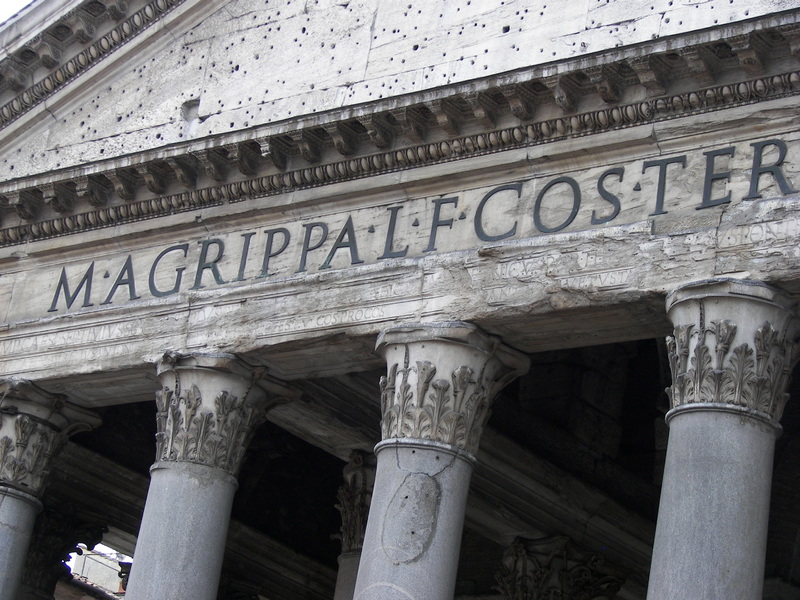Inscription

Detail of the full inscription dedicated to Marcus Agrippa. Below, we see a faint indication of the later inscription by Septimius Severus and Caracalla.

A second detail of the Pantheon's inscription.
M. AGRIPPA. L. COS. TERTIVM. FECIT.
or
Marcus Agrippa, son of Lucius, consul three times, made [this]
On the surface, the inscription on the Pantheon indicates that Marcus Agrippa had commissioned the current building. Because of its clarity, the inscription confused early historians who lacked the technology to establish the monument’s true construction date. After research proved that the monument was a reconstruction, a second debate regarding the benefactor’s identity ensued.
According to historical records, Hadrian was known as a strong patron of the arts, and especially invested in the reconstruction and refurbishment of several ancient monuments around Rome.1 According to the Historia Augusta, Hadrian also practiced the act of restoring the original inscriptions on his renovated monuments without leaving his own name, a testament to his modesty. Some historians argue that this is strong evidence for his involvement, but others have found it contradictory, as several aqueducts and even cities were proudly given his name.2
We know today that the inscriptions kept the same wording as its Agrippan predecessor, though the physical letters themselves were eventually replaced and refurbished — the huge letters, spanning boldly across the architrave (area just above the columns), would have been in gilded bronze.3 In 201-2 AD, Septimius Severus and Caracalla added their own, lengthier inscription underneath Agrippa’s.4 The words are hardly visible today, but in antiquity, they were most likely painted red to improve legibility.5 It reads in translation:
Imperator Caesar Lucius Septimius Severus Pius Pertinax Augustus, Arabicus, Adiabenicus, Parthicus Maximus, Pontifex Maximus, with tribunician power for the 10th time, acclaimed Imperator 11 times, consul three times, Father of the Fatherland, proconsul, and Imperator Caesar Marcus Aurelius Antoninus Pius Felix Augustus [Caracalla], with tribunician power for the 5th time, consul, proconsul, restored with all its refinement the Pantheium, deteriorated by old age; 10 Dec. 201-9 Dec. 202
1 Thorsten Opper, ed. Hadrian: Art, Politics and Economy, (London: British Museum, 2013), 21.
2 Ibid., 21.
3 Ibid., 20.
4 Ibid.
5 Ibid.